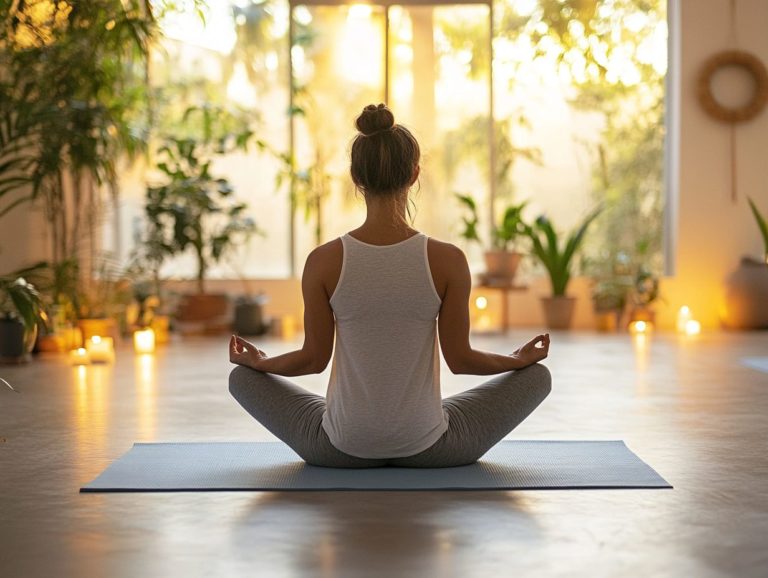A Beginner’s Guide to Meditation Techniques
Meditation is more than a trend; it’s a powerful way to boost your well-being!
This beginner’s guide delves into the essence of meditation, uncovering its multitude of benefits for both body and mind, along with the array of techniques available to you as a practitioner.
Whether you re intrigued by guided sessions, mindfulness, or mantra meditation, you ll find practical tips to embark on your journey.
Explore how to cultivate a serene space, establish a consistent routine, and gracefully navigate the challenges that accompany your meditation practice as a newcomer.
Contents
- Key Takeaways:
- What is Meditation?
- The Benefits of Regular Meditation
- Different Types of Meditation Techniques
- How to Start a Meditation Practice
- Tips for Beginners
- Common Challenges in Meditation
- Frequently Asked Questions
- How do I find a comfortable position for meditation?
- Can I meditate anywhere and at any time?
- How long should I meditate for as a beginner?
- What are some tips for staying focused during meditation?
Key Takeaways:

- Meditation is a practice that helps you achieve mental clarity and inner peace.
- Regular meditation brings physical, mental, and emotional benefits such as reduced stress and improved focus.
- There are various meditation techniques to explore, including guided, mindfulness, transcendental, and mantra meditation. Start with one that resonates with you.
What is Meditation?
Meditation is an expansive practice that embraces various techniques designed to elevate your awareness, foster tranquility, and promote emotional balance. It is a formidable tool for those who aim to cultivate inner harmony and sharpen mental faculties, enabling smoother navigation through life’s many challenges.
Engaging in mindfulness meditation or deep breathing exercises offers distinct advantages, such as stress relief and nurturing compassion principles championed by experts like Richard J. Davidson, Ph.D..
Understanding the essence of meditation can illuminate your path toward a rewarding journey that supports your overall well-being.
The Benefits of Regular Meditation
Regular meditation practice offers a wealth of benefits that can greatly enhance your mental and emotional well-being. It is an essential element of a healthy lifestyle.
Committing to consistent meditation allows you to experience enhanced mental clarity, emotional stability, and effective stress relief, empowering you to tackle daily challenges with grace and composure.
Techniques such as yoga nidra or yogic sleep and mindfulness practices invite a deep relaxation response, encouraging restorative rest while nurturing positive thinking and healthy meditation habits.
Different Types of Meditation Techniques
Meditation offers a rich tapestry of techniques, each designed to cater to a spectrum of needs and preferences. This makes it an inviting practice for everyone, whether you re just starting out or have years of experience.
For those new to meditation, guided sessions provide a helpful framework, while mindfulness meditation invites you to immerse yourself in the present moment.
If you seek deeper focus, transcendental meditation, which emphasizes a specific mantra, can be particularly transformative. Alternatively, breathing meditation nurtures your awareness of the breath, cultivating a profound sense of calm.
As you explore these varied techniques, you’ll discover the method that resonates most deeply with you, enriching your meditation journey in ways you may have never imagined.
Guided Meditation
Guided meditation is a helpful practice that provides a structured approach to meditation. Often led by a skilled instructor or through a thoughtfully designed meditation app, this technique offers verbal guidance. It helps you focus on your breath and trigger that all-important relaxation response.
If you re a beginner, guided meditation can be especially helpful. It eases worries about how to meditate effectively and fosters a profound sense of calm and stillness.
This practice elevates your mindfulness and allows you to become more attuned to your thoughts and feelings. It also serves as a powerful tool for stress reduction and emotional well-being.
If you’re considering this meditative path, think about finding a qualified instructor or choosing reputable apps. These options present a variety of sessions tailored to specific goals, such as improving sleep or alleviating anxiety.
To enhance your experience, carve out a dedicated meditation space. Establish consistent times for your practice. This approach helps you create a tranquil environment that promotes deep relaxation and focus.
Mindfulness Meditation

Mindfulness meditation invites you to cultivate present-moment awareness and acceptance. By focusing on your breathe and bodily sensations, you enhance emotional release and develop compassion for yourself and others.
This technique nurtures a peaceful mind and is a valuable tool for managing stress and anxiety. You ll respond to your thoughts and feelings with greater clarity and calm.
Through consistent practice, you learn to observe your thoughts without judgment. You also reconnect with your inner self, promoting emotional balance.
Simple exercises like body scanning and concentrating on the rhythm of your breath provide a grounding and tranquil experience. These mindfulness techniques create a safe space for you to feel and acknowledge emotions instead of suppressing them.
As you cultivate this awareness, navigating life’s challenges becomes easier. You ll approach them with resilience and grace, nurturing a profound sense of well-being and happiness.
Transcendental Meditation
Transcendental meditation, made famous by Maharishi Mahesh Yogi, involves silently repeating a specific mantra. This guides you toward deep rest and mental clarity.
This practice allows you to transcend ordinary thought, achieving a unique state of restful alertness. By regularly engaging in this form of meditation, you ll notice clearer thinking and less stress!
Rooted in ancient Vedic traditions, transcendental meditation sets itself apart by emphasizing effortless mantra repetition. This technique helps your mind settle into a state of profound stillness.
Unlike concentration-based techniques that demand forceful attention, transcendental meditation cultivates a natural flow. It promotes emotional well-being and improved focus.
Over the decades, countless studies have underscored its benefits, including decreased anxiety, lower blood pressure, and enhanced creativity. These highlight its significant impact on both mental and physical health.
Ready to find your calm? Try exploring these meditation techniques and discover how they can transform your life!
Mantra Meditation
Mantra meditation is an enriching practice that invites you to repeat a specific word or phrase your mantra to cultivate focus and tranquility during your meditation sessions. This technique deepens your connection to your thoughts and emotions and promotes relaxation and emotional equilibrium.
Integrating visualization techniques like imagining peaceful scenes or colors alongside your mantra repetition can elevate your meditation experience. This practice is suitable for both novices and seasoned practitioners.
Selecting the right mantra is crucial. It should resonate with your personal intentions or desires, whether you seek peace, love, or healing. There are various methods to engage in this practice, including silent or vocal repetition and melodic chants that enhance the vibrational quality of your experience.
As you explore these different styles, you ll discover the approach that aligns best with your unique needs. This allows you to cultivate a more fulfilling meditation routine.
Understanding these principles will guide you, enriching your spiritual journey and unveiling profound insights that extend beyond your daily life. This complements your understanding of Zen Buddhism and Taoist China.
How to Start a Meditation Practice
Starting a meditation practice might seem intimidating at first. However, transforming your space into a welcome meditation haven and establishing a daily routine can enrich the experience.
Designating a calming area in your home for meditation can create a serene environment that promotes both focus and relaxation. Embracing simple strategies, like scheduling specific times for your practice, supports your journey and helps you cultivate a sustainable meditation habit that feels enjoyable and fulfilling.
Creating a Comfortable Space
Creating a comfortable meditation space makes your relaxation even better! A dedicated area that promotes stillness and calm can significantly improve your focus and body awareness during practice, allowing you to immerse yourself in your meditation journey.
Simple adjustments such as using cushions, soft lighting, and calming scents can transform any space into a sanctuary for mindfulness and relaxation.
To elevate this sanctuary, consider incorporating gentle music or nature sounds. This enriches the ambiance and helps drown out distracting noise. The choice of seating is also crucial; a supportive meditation chair or yoga mat will facilitate better posture and breathing, enhancing your overall comfort and supporting body awareness.
Adding personal touches, such as plants or sacred objects, fosters a deeper connection and cultivates a sense of peace. With these elements harmoniously combined, you can create an inviting environment that encourages a more profound engagement with relaxation techniques and promotes holistic body awareness, facilitating inner harmony.
Setting a Routine

Establishing a consistent meditation routine is essential for beginners aspiring to cultivate lasting meditation habits. By dedicating time each day, you lay a strong foundation for your meditation journey, reinforcing the value of mindfulness in your everyday life.
Consider employing various meditation techniques, like gradually extending the length of your sessions and exploring different methods. This keeps your practice both engaging and rewarding.
To amplify the effectiveness of your meditation experience, schedule your sessions at the same time each day be it in the morning, during your lunch break, or just before bedtime. This regularity helps you build a habit and signals to your mind that it s time to pause and reflect.
Tracking your progress in a journal can serve as a significant motivator, offering insights into the evolution of your meditation practice while reminding you of the tranquility you can attain. Ultimately, embracing these routines fosters a deeper connection to self-awareness, significantly enhancing the transformative power of meditation in your life.
Tips for Beginners
For someone new to meditation, mastering the art of managing distractions and navigating thoughts and emotions is essential for cultivating a fulfilling practice. Beginners often encounter challenges in maintaining focus during their sessions. However, with the right strategies, the experience can be significantly enhanced.
Techniques like gently returning your attention to the breath during focus meditation can help overcome wandering thoughts. This allows you to foster a deeper connection with the present moment.
Managing Distractions
Managing distractions effectively is key to maintaining focus during meditation, especially for those just starting out. New practitioners might find their thoughts wandering or get sidetracked by external noises. By using techniques like breath awareness and gently redirecting your focus, you can minimize the effects of distractions and enrich your meditation practice.
Over time, as you learn to acknowledge and release these distractions, you’ll cultivate a deeper sense of stillness and presence.
Creating an environment that supports your practice can elevate this experience. Choose a quiet space and limit potential interruptions to set the stage for deeper focus. You might also find that incorporating sound techniques, such as calming music or nature sounds, helps anchor your attention.
For beginners, setting a timer for shorter sessions can alleviate anxiety about how long to meditate. This makes it easier to ease into the practice.
Using mantra repetition can provide a focal point, gently steering your mind back whenever it starts to drift. This blend of strategies not only enhances concentration but also deepens your connection to breath awareness, which is essential for maintaining a centered state of mind.
Dealing with Thoughts and Emotions
Ever feel overwhelmed by your thoughts during meditation? Dealing with thoughts and emotions is a common challenge, yet it presents some of the most valuable opportunities for emotional release and growth.
Discover how observing your thoughts without judgment can transform your meditation experience! You can learn to cultivate mindfulness and develop healthier responses to your emotions.
By embracing meditation tips that promote acceptance and compassion, you can effectively navigate your emotional landscape, enhancing your overall meditation experience.
Incorporating deep breathing exercises and visualization techniques can guide you toward a more centered state. When feelings arise, it s helpful to view them as temporary visitors rather than permanent fixtures. This shift in perspective allows you to release pent-up emotions without feeling overwhelmed.
Maintaining a consistent meditation practice strengthens your ability to stay present. It also builds resilience in the face of life’s challenges. By adopting these strategies, you support your emotional well-being and deepen your understanding of yourself, leading to a more fulfilling meditative journey.
Common Challenges in Meditation
While meditation presents a wealth of benefits, you may often face common challenges that could impede your progress. These include maintaining focus, handling strong feelings, and dealing with physical discomfort.
These hurdles are especially common for beginners, who might struggle to quiet their minds or sit comfortably for longer durations.
By recognizing these challenges and utilizing targeted meditation tips, you can effectively overcome these barriers. This paves the way for a more rewarding meditation practice that leads to mental skills.
Frequently Asked Questions

What is meditation and why should I try it?
Meditation is a practice that involves focusing your mind on a particular object, thought, or activity to achieve a state of calmness and relaxation. It has been shown to reduce stress and anxiety, improve focus and concentration, and promote emotional well-being.
What are some common meditation techniques for beginners?
Some common meditation techniques for beginners include mindfulness meditation, guided meditation, and mantra meditation. Mindfulness meditation involves focusing on the present moment. Guided meditation uses audio or visual guidance to help you relax and focus. Mantra meditation involves repeating a word or phrase to help you clear your mind.
How do I find a comfortable position for meditation?
Finding a comfortable position for meditation is crucial for relaxation and focus. You can sit cross-legged on a cushion, in a chair with your feet firmly on the ground, or lie on your back if that feels best.
Can I meditate anywhere and at any time?
You can meditate wherever and whenever you want! Just find a spot that feels right, but make sure it s quiet and free from distractions.
How long should I meditate for as a beginner?
As a beginner, start with shorter sessions of about 5-10 minutes. Gradually increase the length as you feel more comfortable. The key is to find a time that suits you and stay consistent!
What are some tips for staying focused during meditation?
Staying focused during meditation can be challenging, especially for beginners. Here are some helpful tips:
- Focus on your breath.
- Use a guided meditation (listening to someone lead you through the process).
- Set a timer to keep track of your time.
- Acknowledge and let go of distracting thoughts.
It s time to start your journey into meditation!






